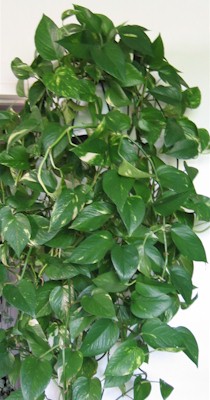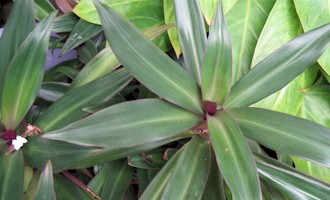|
Philodendron |
Family : araceae |
| Number of species : 500 | |
| Country of origin : South America |
| Philo's are definitely amongst those which seem to enjoy the appartment's living room atmosphere. Almost all of them are growing fine, and the oldest ones have even reached a fair size, in comparison with samples from wild life. |
|
Monstera deliciosa A 5-year old monstera deliciosa occupies alone a whole corner of the room. |
|
|
|
To ensure the plant's stability (it must be something like 25 kg !), 3 thick wooden supports are fixed to the walls and prevent the main stems from collapsing. Leaves are cleaned twice a year with a water and natural soap solution.
|
|
|
Philodendron scandens |
|
|
This philodendron scandens took less than 2 years to cover entirely the bamboo
support. |
|
|
|
| A lot of cuttings were taken from this plant, which satisfies with a
dark place of the living room. At its bottom, groundplants such as maranta
leuconeura have found a quiet place to settle.
|
 |
||
|
Philodendron trubii |
|
|
Philodendron brasil, emerald king |
|
 |
Who said philo's hardly bloom in interior ?! These two philodendron brasil (left) and philodendron emerald king (bottom, right) produce up to 2 flowers every month.
|
 |
|
|
Philodendron brasil
(below) was purchased in a 13cm container, and is now 1,8m high.
|
| Other samples of philodendron, such as
philodendron selloum (left), with light green leaves and smelly
stems, phildendron bipinnatifidum (center) or other undetermined
species (right, probably an hybrid of p. scandens). |
|
|
|
 |
Philodendron cobra
(right) enjoys shaded light, as its dark green leaves let bet. |
|
| These
three are samples of philodendron brought back from tropical forest in
Guadeloupe (oct. 03). They survived the journey and restarted growth in 2
months. |
||
|
|
|
 |
| A heavy scindapsus aureus (so-called pothos) can't help growing, in
spite of a relatively small container. A lot of cuttings were made from this
plant, as one can imagine easily. |
||
|
Rhoeo spathacea |
|
 |
|
Rhoeo spathacea (right)
is not a philodendron, but requires more or less the same growing
conditions. This sample grows in direct sunlight, in a very light soil
mainly composed of peat moss. It requires frequent and abundant waterings.
|
||